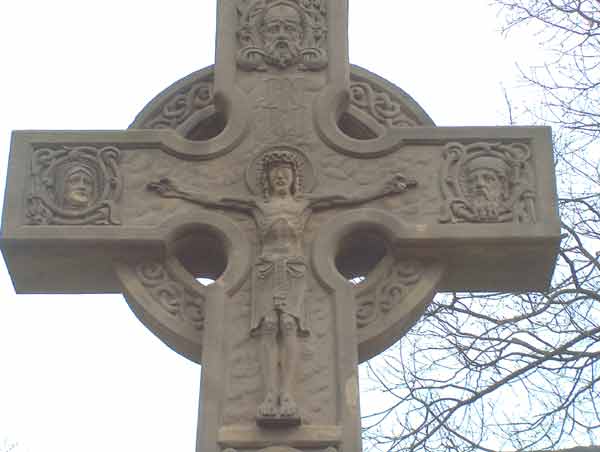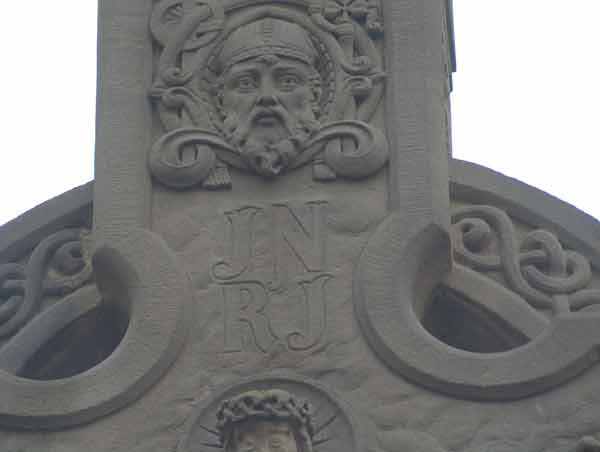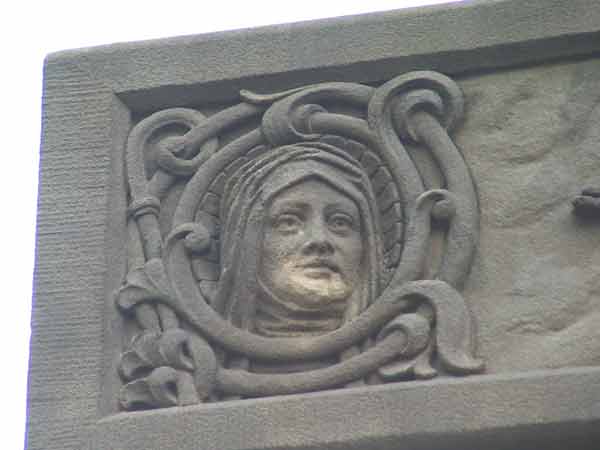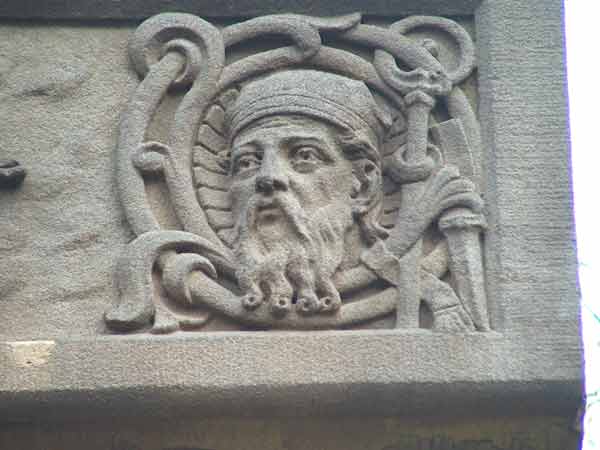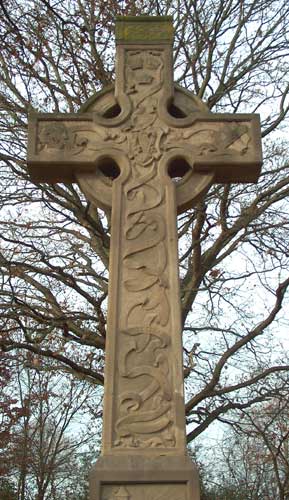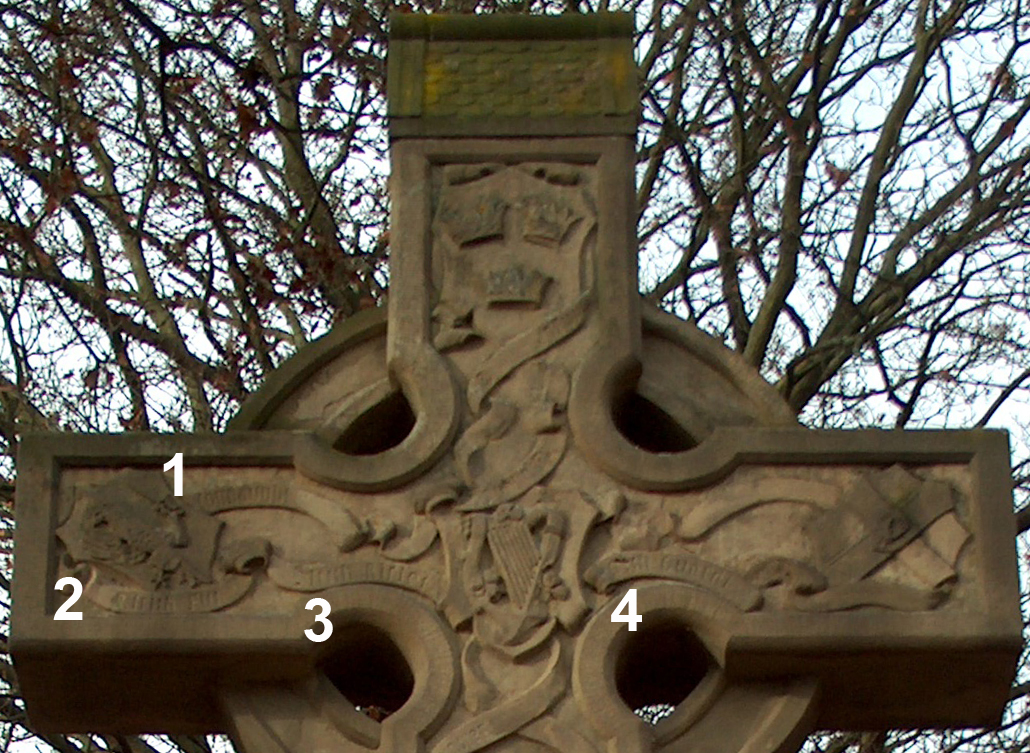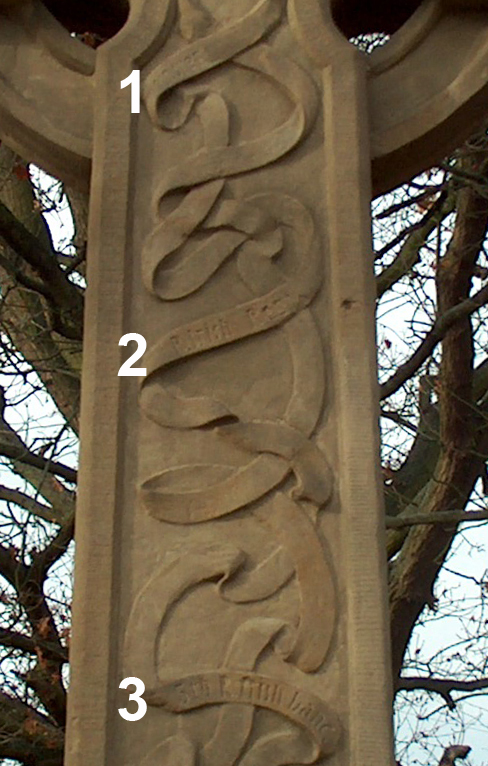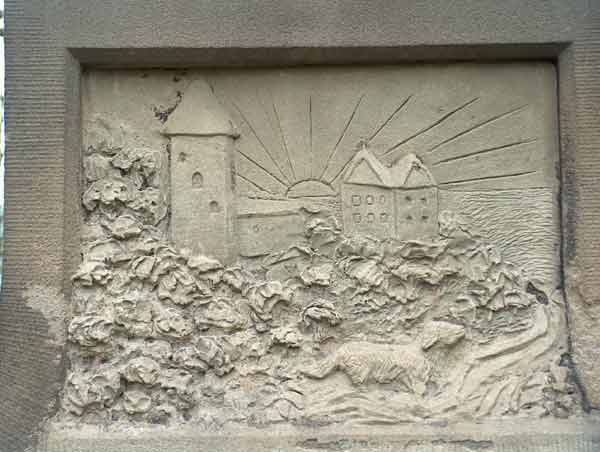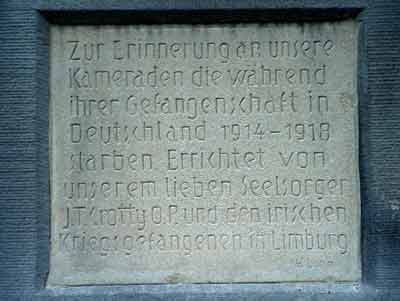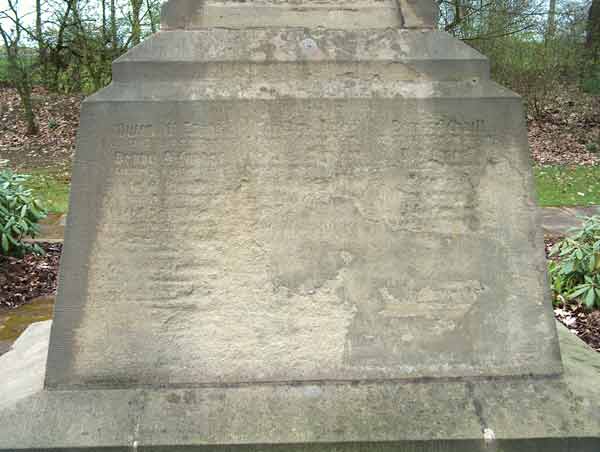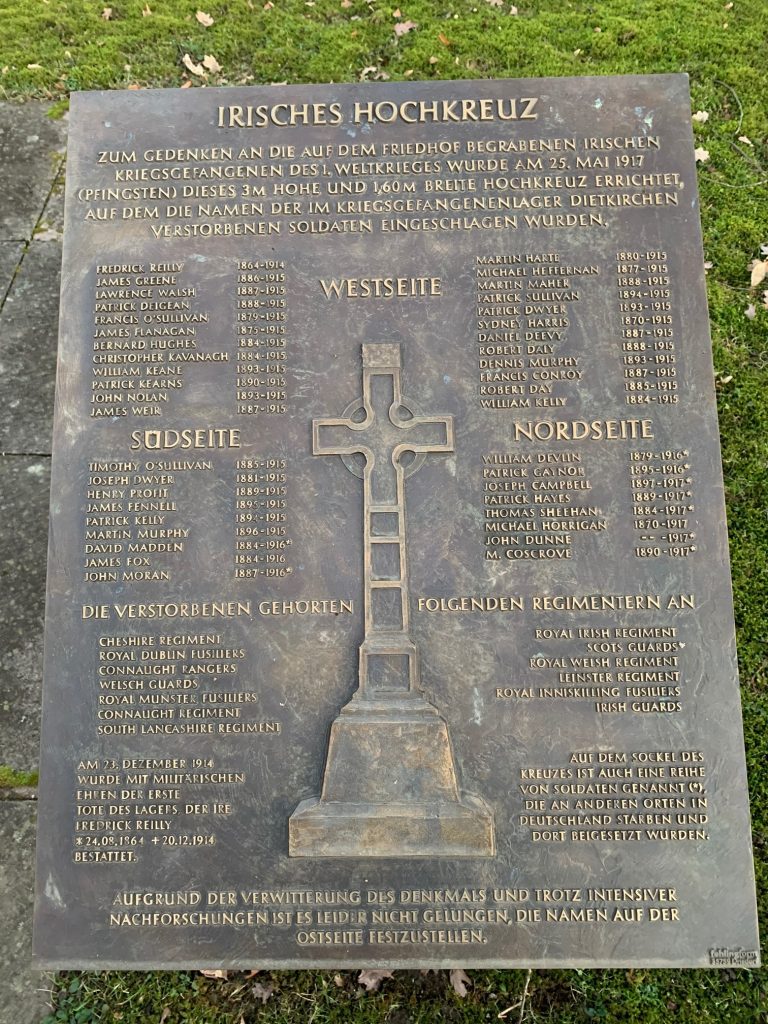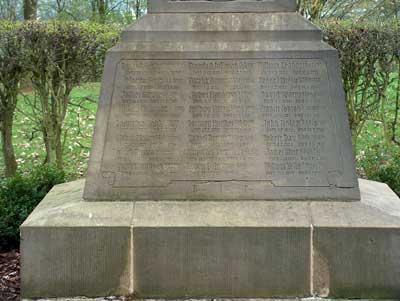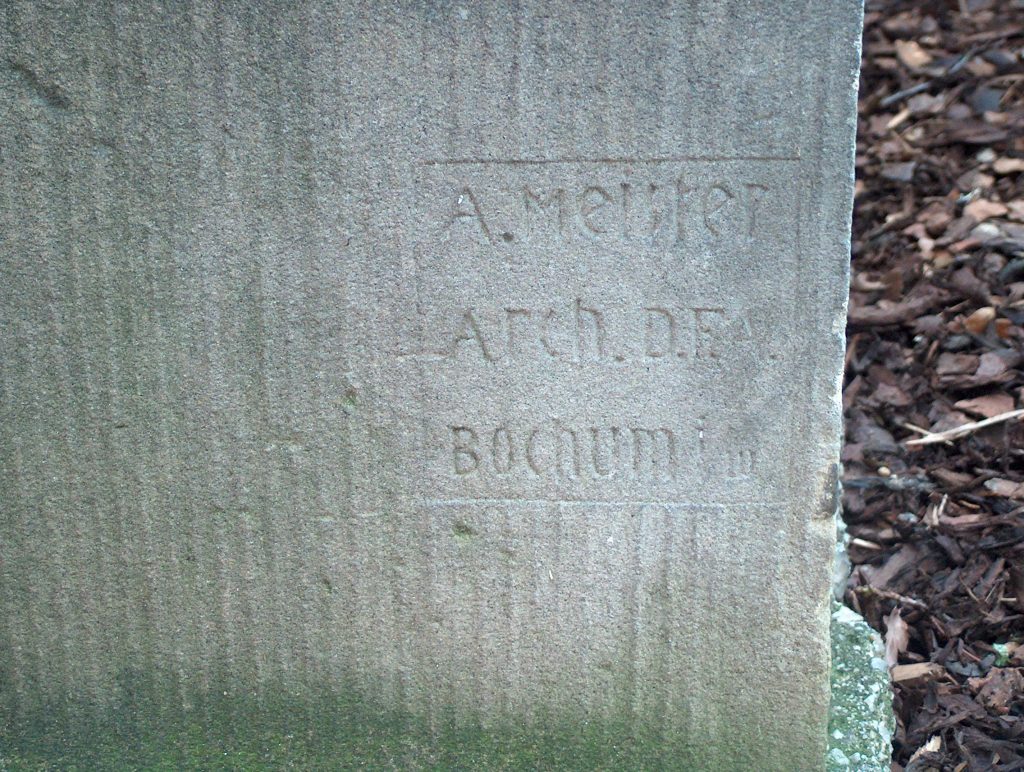The Irish Cross in detailled pictures
(all pictures ©Ludwig Ries)
Cross Front (West side)
You can see Christ on the cross, framed by 2 reliefs of saints, while an image of St. Patrick watches above the figure of Christ. Saint Patrick is considered the patron saint of Ireland.
Below the Christ figure are 3 motive elements with various typical Irish braiding or knotting patterns. Detailed images can be accessed in a separate page via the menu.
A steep gable roof is attached to the cross, the sides of the roof face east and west.
The cross is rounded inwards in a quarter circle at the intersection of the horizontal trunk and the crossbeam. The typical cross ring around the intersection of the horizontal trunk and the cross beam rounds off the main features of a Celtic cross.
The bases elements are also explained in detail in separate pictures.
Cross tip (West side)
On the left and right of the cross there are two more figures. It can be assumed that these are the 2 other patron saints of Ireland:
- on the left St. Brigid
- on the right St. Comcille also called St. Columba
The circle around the intersection of the cross is decorated with braided patterns.
Cross tip top – St. Patrick (West side)
Above the head of the figure of Christ, directly under the roof of the cross, St. Patrick is depicted. He is the most important patron saint of Ireland.
Between him and the head of Christ the letters INRI are engraved in two lines.
The image of St. Patrick is decorated with a woven ribbon. On the upper left next to his face his crosier with a cross can be seen.
Tip of the crossbar left (West side)
As already described above, this portrait is possibly of St. Brigid, also a patron saint of Ireland. Her head is also framed with a tendril-like weave.
In the background of the head there are uniform radiations, which can possibly be interpreted as flames of fire. Fire flames above the head are considered an attribute of St. Brigid.
Tip of the crossbar on the right (West side)
This relief may show St. Comcille. He is also called St. Columban or Kolumban. But in his case the meaning of the dagger is unclear.
The dagger as an attribute of a saint can be assigned only to St. Kilian in the case of an Irish saint. However, St. Kilian was mainly missionary active near Würzburg and probably did not play a major role in Irland itself.
It seems therefore more likely that the Irish prisoners of war had rather direct country related saints on the cross realized. What is more obvious in such a case than to have the 3 great patron saints of Ireland engraved on the cross:
- Saint Patrick
- Saint Brigid
- Saint Comcille/Columban/Kolumban
Back side of the cross (East side)
The description of the design of the reverse side can be read in the Dietkirchen School Chronicle as follows:
On the back you can see four Irish coats of arms: high above three crowns, in the middle the harp, on the left the eagle with the sword, on the right an outstretched hand.
At this point in the description the writer of the Dietkirchen school chronicle seems not to have been precise enough or has not questioned the meaning of the coats of arms.
It is very likely that the coats of arms are the four provinces of Ireland, which are represented with their attributes:
- the harp representing Leinster
- the three crowns are Munster
- the outstretched hand is Ulster
- Raven and sword arm represent Connacht
Below the harp the cross stem is decorated with a braided band.
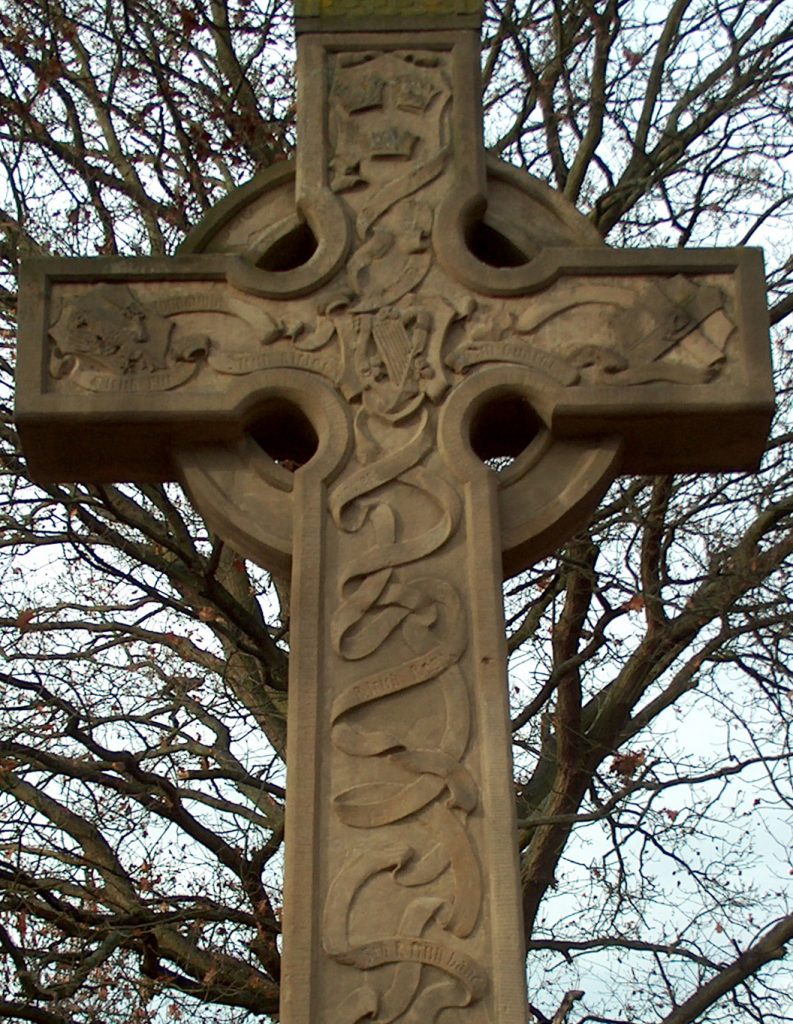
Unfortunately, the cross has again been heavily weathered since the time of renovation until today. The details of the motifs are now relatively difficult to see.
From the renovation in 2007 until today in 2020, just under 13 years have passed and it now seems that another renovation is necessary.
The individual elements are so badly weathered that it is almost impossible to see any details.
A proper renovation with possible reworking of the individual elements seems to be urgently necessary, otherwise in a few years there will be only a sandstone cross on the cemetery where not much is recognizable anymore.
The motifs that characterize the cross in particular will then probably no longer be recognizable in their fineness.
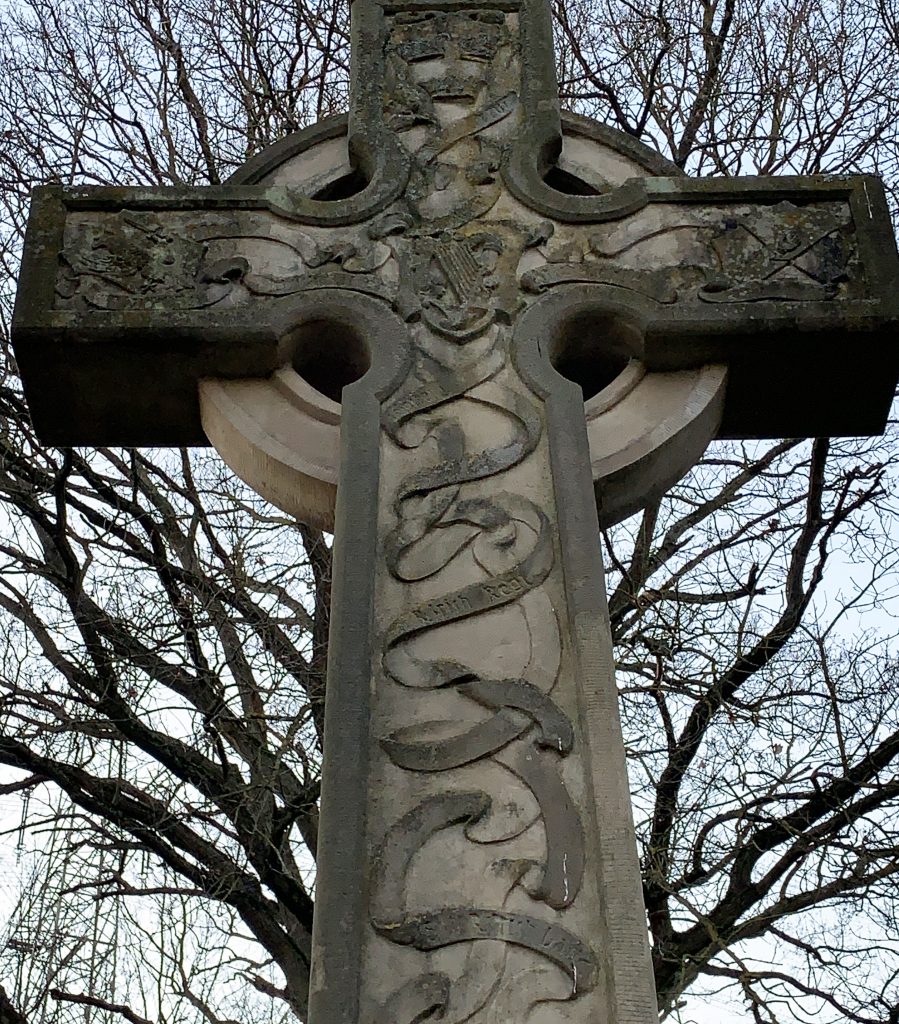
The backsite of the cross contains some more details available as a surprise.
For example, the regiments to which the Irish prisoners of war belonged are engraved on decorative bands.
In the following the inscriptions on the upper part of the cross, some of which are very difficult to decipher, and their meaning:
| Inscription | Meaning | |
| 1 | Connaught | Connaught Rangers, disbanded 1922 |
| 2 | R. Irish Fus. |
Royal Irish Fuseliers |
| 3 | R. Irish Rifles | Royal Irish Rifles |
| 4 | Irish Guards | Irish Guards |
It appears that there was also an entry under the three crowns and under the harp. However, these two engravings are so weathered that nothing can be seen anymore. It is possible that a technical scientific method of investigation could be used to find out what was engraved in these ribbon loops.
Below are the inscriptions in the trunk of the cross, some of which are very difficult to decipher, and their meaning.
| Inscription | Meaning | |
| 1 | no longer legible | |
| 2 | R. Irish Reg. | Royal Irish Regiment, disbanded 1922 |
| 3 | 5th R. Irish Lanc | 5th Royal Irish Lancers, disbanded 1921 |
Base upper part (East side)
The Dietkirchen school chronicle describes this portrait as follows:
The lower part of the cross bears an extremely symbolic relief on the back. The rising sun sends its rays, probably the hope of the Irish people. At a small chapel in the relief, a small cross stands upright, pointing to the help of God; a small falling cross symbolises the deceptive hopes of this earth. The dog, as a symbol of vigilance, points to the future, the Irish people want to be vigilant, awaiting the appropriate moment of liberation from long suffering.
Even from today’s point of view there seems to be nothing to add or further interpret to this explanation.
Base upper part
left pictore North side – right picture South side
Text on the North side of the base upper part:
In memory of our comrades
in arms who perished
during their imprisonment
of war in Germany 1914-1918
Erected by our beloved
chaplain J.T. Crotty O.P.
and the Irish prisoners
of war in Limburg / Lahn
Text on the South side of the base upper part:
Zur Erinnerung an unsere
Kameraden die während
ihrer Gefangenschaft in
Deutschland 1914-1918
starben. Errichtet von
unserem lieben Seelsorger
J.T. Crotty O.P. und den irischen
Kriegsgefangenen in Limburg.
Base upper part (West side)
The text in this shield-like background, decorated with band ornaments, seems to be the same text as that seen on the north and south sides of the upper part of the base. It is written in Irish, a language strongly rooted in Gaelic.
However, as this text only seems to refer to 1914-15-17, it is reasonable to assume that this side of the upper pedestal was already present when the cross was erected in 1917, while the north and south side inscriptions were apparently added later, as they refer to 1914-1918. So they must have been added later.
Base lower part (East side)
On this base side as well as on 3 other sides 84 names of Irish soldiers resting in the cemetery were engraved. Unfortunately especially this eastern side was attacked extremely strong by wind and weather over the decades, so that the names were no longer legible.
During the renovation of the cross in 2007 a bronze plate was made on which the names can be read.
Bronze plate (right hand before the cross on the west side)
Bronze plate with the names of the deceased Irish prisoners of war, buried in the cemetery, whose names were engraved on the base of the Irish High Cross.
Unfortunately, the names on the eastern pedestal side could neither be reconstructed nor could they be determined, despite extensive research.
The top text says:
Irish High Cross
To commemorate the Irish prisoners of war of World War I buried in the cemetery, this 3 m high and 1.60 m wide high cross was erected on 23 May 1917 (Whitsun), on which the names of the soldiers are engraved who died in the Dietkirchen prisoner of war camp.
The text at the bottom says:
Due to the weathering of the monument and despite intensive research, it has unfortunately not been possible to determine the names on the eastern side.
Base lower part (West side)
On this base side as well as on 3 other sides 84 names of Irish soldiers resting in the cemetery were engraved.
Base lower part (North side)
On this base side as well as on 3 other sides 84 names of Irish soldiers resting in the cemetery were engraved.
Base lower part (South side)
On this base side as well as on 3 other sides 84 names of Irish soldiers resting in the cemetery were engraved.
Signature with reference to the architect of the cross.
Inscription:
A. Meister
Arch. D.F.A.
Bochum / W.
According to own research it can be assumed that the architect’s first name was Anton.
The abbreviation D.F.A means: Deutsche Freie Architektenschaft.
The “W” behind Bochum is an abbreviation for Westphalia.
In 1919 the former BDA (Association of German Architects), the German Free Architects’ Association (DFA) and the German Architects’ Association (DA) decided to unite to form the new BDA.


